
94% of researchers rate our articles as excellent or good
Learn more about the work of our research integrity team to safeguard the quality of each article we publish.
Find out more
ORIGINAL RESEARCH article
Front. Environ. Sci. , 25 April 2022
Sec. Environmental Economics and Management
Volume 10 - 2022 | https://doi.org/10.3389/fenvs.2022.884754
This article is part of the Research Topic Export Product Quality, Renewable Energy, and Sustainable Production View all 48 articles
Natural disasters have a major detrimental impact on agricultural production. In recent decades, China has experienced more frequent natural disasters as a result of climate change. Although the spatial and temporal changes in natural disasters for individual catastrophic activities are well understood, the impact of several disasters on cereal crop productivity and subsequent quality loss remains unknown. Furthermore, due to the key significance of cereal in China’s daily diet, a decrease in cereal quality, namely protein, will have a detrimental effect on nutrient supply. To better understand the relationship between natural disasters and cereal crop food quality in China, we used province-level data from 1988 to 2020 to construct a dataset of natural disasters, crop production, and protein contents of cereal crops (rice, wheat, and maize). Our findings suggest that activities in areas affected by natural disasters have decreased dramatically since the 21st century, with changes in areas affected by such disasters varying by province. Between 1988 and 2020, the total protein losses from grain and straw harvests due to natural disasters were 11.93 and 391.27 million tons. Overall, the annual mean total protein loss in maize, rice, and wheat was 4,982.26, 5,055.4, and 4,200.34 thousand tons, respectively. Although was responsible for half of the protein losses in more than half of the provinces. Drought and floods accounted for 80% of the total area affected by all natural disasters.
Natural disasters, which are described as unavoidable natural phenomena that occur all over the world, can cause significant property damage and loss of life. The 2018 State of Food Security and Nutrition in the World report shows that (Organization 2018), extreme weather conditions such as natural disasters have a negative impact on agricultural productivity, food production, and existing food growing practices, thereby widening the food supply gap over a longer period of time (Lesk et al., 2016). Droughts, floods, low-temperature events, hailstorms, and typhoons are among the natural disasters that have a profound effect on agriculture (Guan et al., 2015), although predicting the intensity of such natural disasters in advance allows communities to take measures to sustain food production as much as possible (Wang et al., 2020). As the world’s largest producer and consumer of cereals, China is increasingly studying the effects of natural disasters on cereal yields within China in the context of more frequent natural disasters (Lei and Wang 2014). For example, Long Fang et al. studied the impact of natural disasters on grain yields in China and showed that the rate of natural disaster success has a large impact on rice yield (Fang et al., 2011). As protein is the second most abundant nutrient in cereals besides carbohydrates, we can hypothesize that the impact of natural disasters on agriculture will result in changes in cereal protein yields.
Protein is an extremely complex nitrogen-containing organic molecule that serves as the basic foundation for life (Heird 1998; Westerterp-Plantenga 2003). Protein supply is a direct indicator of people’s physical and mental well-being, as well as an essential emblem of a country’s economic, scientific, and cultural development (Wardlaw and Insel 1996; Luo 2006). Because China has such a large population, ensuring an adequate protein supply and improving the level of quality protein has always been a priority for the country’s food plan (Luo 2006). Because the majority of animal protein is obtained through the consumption of plant protein, increasing plant protein production, particularly cereal protein, has become the key to solving this problem. Grains such as rice, corn and wheat are rich in protein (7–15% of dry weight), which makes them an important source of protein for human needs. Cereal protein raw materials are abundant and inexpensive, and they have unrivaled functions and a vast potential for application in the food industry, whether as food additives or protein sources (Wang and Kang 2006). China is experiencing a higher demand for food as its population grows and its economy develops, yet the trend of declining arable land and water resources in China is unstoppable year after year (Luo 2006). In this context, increasing grain protein yield per unit of arable land is gradually becoming a high-profile research topic (Luo 2006). In addition, although straw is not high in protein, it is an important source of protein when formulating feeds for livestock, especially fast-growing monogastric animals such as pigs and poultry (Shewry 2007). In 2017, worldwide wheat, maize, and rice output totaled 0.772, 1.13, and 0.770 billion tons, respectively. In China, agriculture accounted for 14.3, 14.2, and 25% of totals http://www.fao.org/faostat/zh/# data/QC/visualize). Grain and straw harvests from cereal crops (wheat, maize, and rice) in China totaled more than 0.46 and 0.81 million tons, respectively (Zheng et al., 2020).
Natural disasters have always struck China as a result of its complex geographical environment and the regular occurrence of the East Asian monsoon (Simelton 2011; Zhou et al., 2013). These repeated calamities have hampered China’s economy and society’s long-term growth. For example, natural disasters, cost the Chinese economy 264.5 billion RMB in 2018, affecting 130 million people and resulting in 589 deaths, as well as damaging 20.8 million hectares (ha) of cropland. As a result, natural disasters have a detrimental impact on China’s food output. Although some previous research has looked into the spatiotemporal patterns of natural disasters and their effects on grain production (Shi and Tao 2014; Du et al., 2015), no complete analysis of multiple major natural disasters and their impacts on various cereal crops has been performed (Guo et al., 2019). Furthermore, although cereals such as rice, maize and wheat provide 37% of the protein in the global human diet (Liu et al., 2021), o our knowledge, no study has estimated losses in the cereal protein harvest due to natural disasters.
To examine the relationship between climatic events and grain protein content, we collected datasets on natural disasters and crop output in China from 1988 to 2020, using data at the provincial level, and assessed the protein levels of different cereal crops. We also asked the following three questions: 1) How have natural disasters affected different cereal harvests in China over the last 3 decades? 2) What are the different effects of natural disasters on different cereal crops in different spatial dimensions? 3) During the time period selected for this study, how much protein was lost as a result of various natural disasters?
The People’s Republic of China, is the third largest country in the world in terms of land area, and the results of the seventh national census of China show that its total population is 144, 349, 7378, ranking first in the world. This means that China supports more than 20% of the world’s population with only 7% of the world’s land area, and sustainable agricultural production therefore plays a crucial role in China’s food security (Zhao et al., 2022b; Xia et al., 2022). Cereal production areas are widely distributed in China, and the country’s vast size, the wide latitudinal span between north and south and the complexity and diversity of its climate have led to the occurrence of many different types of natural disasters throughout the country (Song et al., 2020; Shahzad et al., 2022). Therefore, to ensure the comprehensiveness of the study, this paper collected data on natural disasters and cereal production in all provincial-level regions within China except Hong Kong, Macau, and Taiwan (data for these three regions were not available) between 1988 and 2020, and used them to investigate the changes in natural disasters and their effects on cereal protein harvest within each province and six geographic regions of China during the corresponding time period. According to the traditional definition, the six geographical regions of China are defined as Northeast (NE), North China (N), the Changjiang River region (CJ), Northwest (NW), Southwest (SW), and Southeast (SE) (Shutian et al., 2011) (Supplementary Table S1). These six geographic regions tend to have very different climatic characteristics, which results in them often receiving different natural disasters.
The statistics for natural disasters are from the China Rural Statistics Yearbook (http://data.cnki.net/yearbook/single/N201903022_0). The yearly areas of various disaster effect intensities were included in these statistics. There were three levels of disaster intensity: mild (grain loss between 10 and 30%), moderate (30–70%), and severe (>70%). In addition, data on the areas impacted by natural disasters such as floods, droughts, cold temperatures, and hail were gathered. The China Agriculture Statistical Report (http://data.cnki.net/yearbook/Single/N2017120001) was used to obtain cultivation areas and productivity statistics for cereal crops. Finally, all information was gathered and analyzed at the provincial level.
The formulas utilized to compute the protein loss due to natural disasters from grain across the full study area are Eqs. 1–5.
Where i denotes the province, k the crop type, and j the disaster type; PLGrain and PLStraw (ton) represents the total protein loss from grain and straw in China; The yield of each crop per hectare is referred to as the Yield. The disaster-affected area is represented by AD. The ratio of different cereal cultivation areas is represented by CAR. Pro represents the protein content of different cereal crop’s grain or straw. The loss of grain caused by various levels of natural disaster intensity is referred to as Int. STR stands for the rate of straw return in various provinces and for various cereal crops. The rate of straw burning in different provinces and for different cereal harvests is represented by STB. The standard deviation of the different natural disasters’ intensities is represented by SD. The conversion factor in the equations is 0.01, which represents the standard deviation of the intensities of the various natural disasters. The parameters stated above include detailed information, which is presented below. Supplementary Table S2 shows the grain to straw ratio, which was derived from the references therein (Liu and Li 2017). Supplementary Table S3 and Supplementary Table S4 show the straw returning rates and straw burning rates in different regions for wheat, maize, and rice over different study periods (Liu and Li 2017). Supplementary Table S5 shows the severity of natural disasters. Supplementary Table S6 shows the average protein content of wheat, maize and rice in different provinces based on data from the China Crop Germplasm Resources Information Network (https://www.cgris.net/), Crop straw feed processing and application and National Library of Standards (http://www.nssi.org.cn/), China (Xing 2008).
Linear regression was used to determine the change in protein losses due to natural disasters and the change in affected areas in each province from 1988 to 2020. The R programming language was used to conduct all statistical analyses and create graphs (Wang and Kang 2006; Null et al., 2011).
Changes in the areas impacted by disasters at three levels of intensity exhibited similar trends (Figure 1). Drought and floods were the most widespread of the four natural disasters examined in this study, accounting for 80% of the total area affected by all natural disasters. By cereal type, the affected area for maize increased before 2003 and then decreased afterwards. For rice and wheat, a linear decrease was observed in the mild effect category from 1988 to 2020 and in the moderate and severe effect categories after 2000. Before 2000, flat trends were observed in the moderate and severe effect categories. The ratio of affected cereal area to total crop area for each degree of disaster has shown a trend of first increasing and then decreasing over the past 3 decades (Figure 2). Most reached a maximum around 2000, different from that the trends shown in Figure 1. As shown in Figure 3, the areas affected by mild, moderate, and severe effects accounted for 48.50, 25.31, and 6.07% of the cultivated cereal area in each of the three categories. Furthermore, the highest percentages of cultivated area affected by the mild effect, moderate effect, and severe effect were 77.05, 42.33, and 11.89%, respectively. Despite the negative effects of natural disasters on crop yields, cereal grain yield has continued to increase throughout time (Figure 4); yields of rice and corn in China in 2020 were 6,861.74 kg/ha, 5,327.08 kg/ha and 5,971.33 kg/ha, respectively.
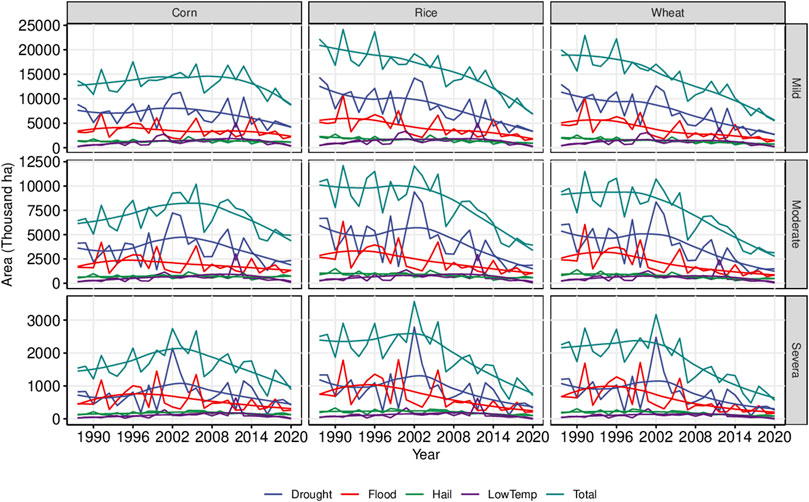
FIGURE 1. Trends in the area affected by natural disasters from 1988 to 2020. The smooth lines in each panel represent loss trends.
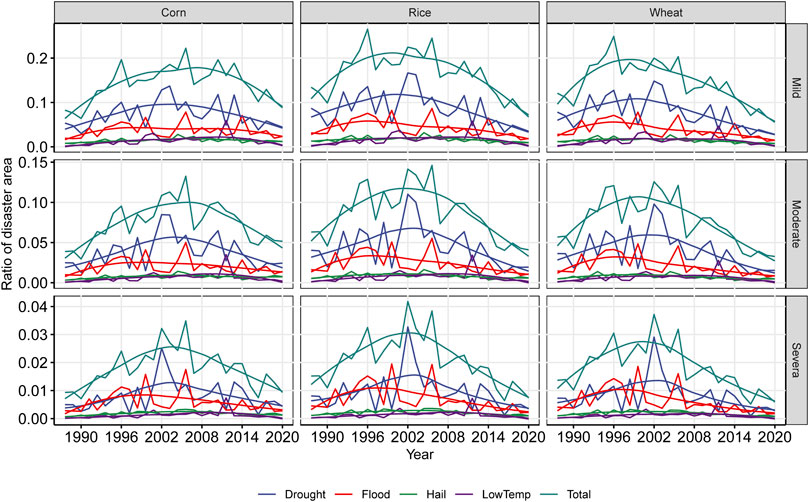
FIGURE 2. Trends in the ratio of the natural disaster-affected area to the total cultivation area for different disaster intensities and different crops from 1988 to 2020. The smooth lines in each panel represent loss trends.
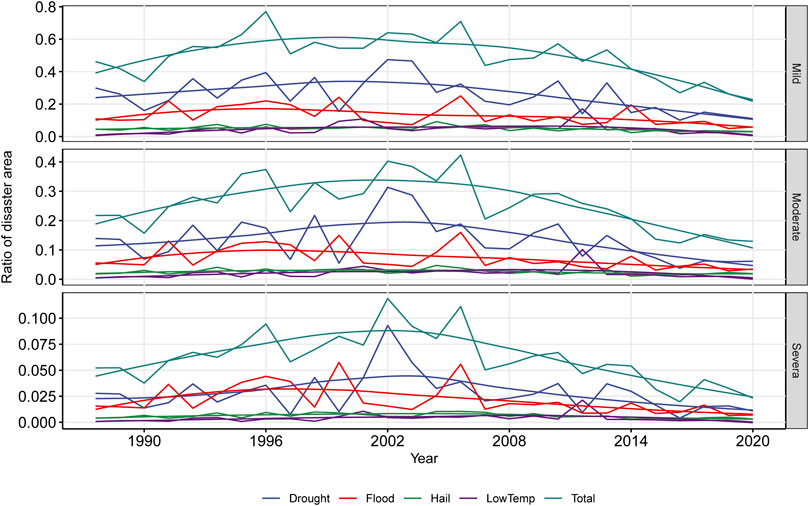
FIGURE 3. Trends in the ratio of the area affected by each natural disaster type to the total cultivation area from 1988 to 2020. The smooth lines in each panel represent loss trends.
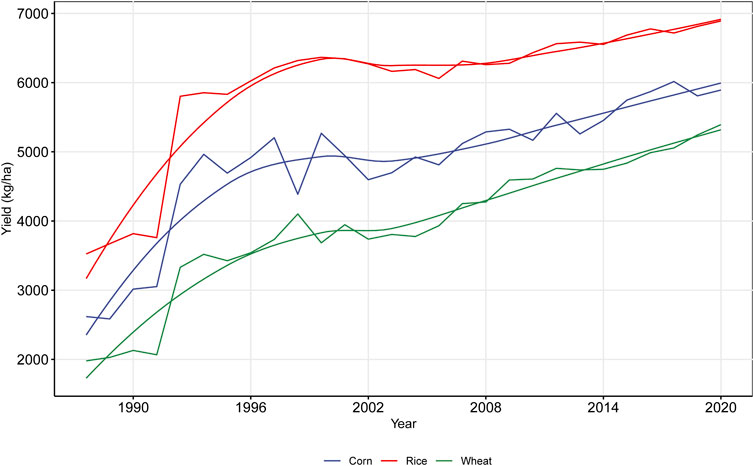
FIGURE 4. Changes in the yield of rice, wheat, and maize in China from 1988 to 2020. The smooth lines in each panel represent loss trends.
There were regional differences in the areas affected by mild (Figure 5), moderate (Figure 6) and severe (Figure 7) natural disasters at the provincial level. For maize in the NE, N, and Inner Mongolia in the NW, drought was the primary disaster; for rice in the CJ and SE, drought and flooding were the primary disasters that affected production regions; and for wheat in the N, drought was the primary disaster. For moderate disasters (Figure 6), the impacted areas for maize and rice showed a pattern similar to that for mild disasters at the provincial level, whereas the affected area for wheat declined rapidly after 2003. For severe disasters (Figure 7), drought affected maize in the North region and Inner Mongolia; flood affected rice in the provinces of Jiangxi and Hunan; and drought affected wheat in the provinces of Shandong, Henan, and Shanxi.
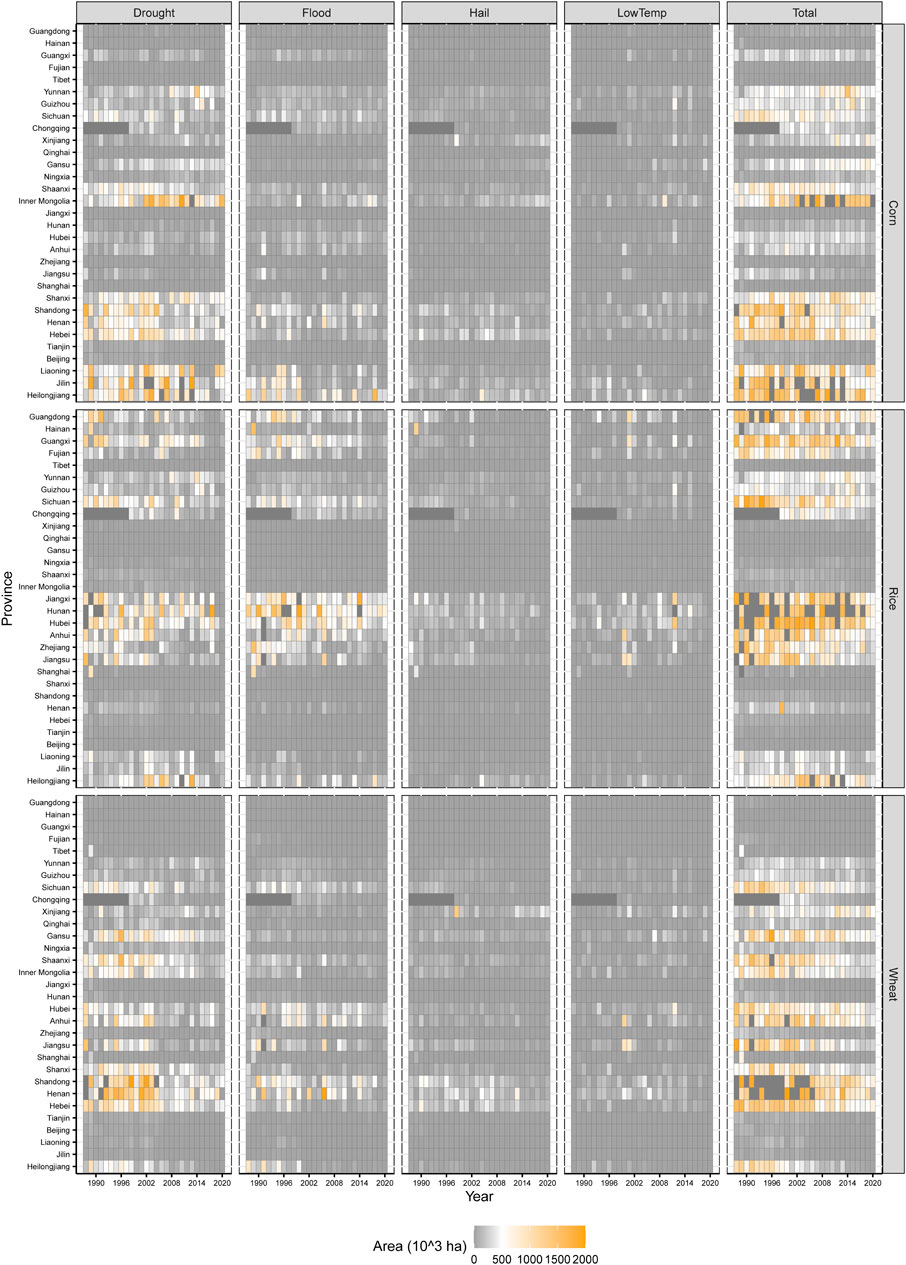
FIGURE 5. Changes in the area affected by different mild natural disasters for rice, maize, and wheat in each province from 1988 to 2020.
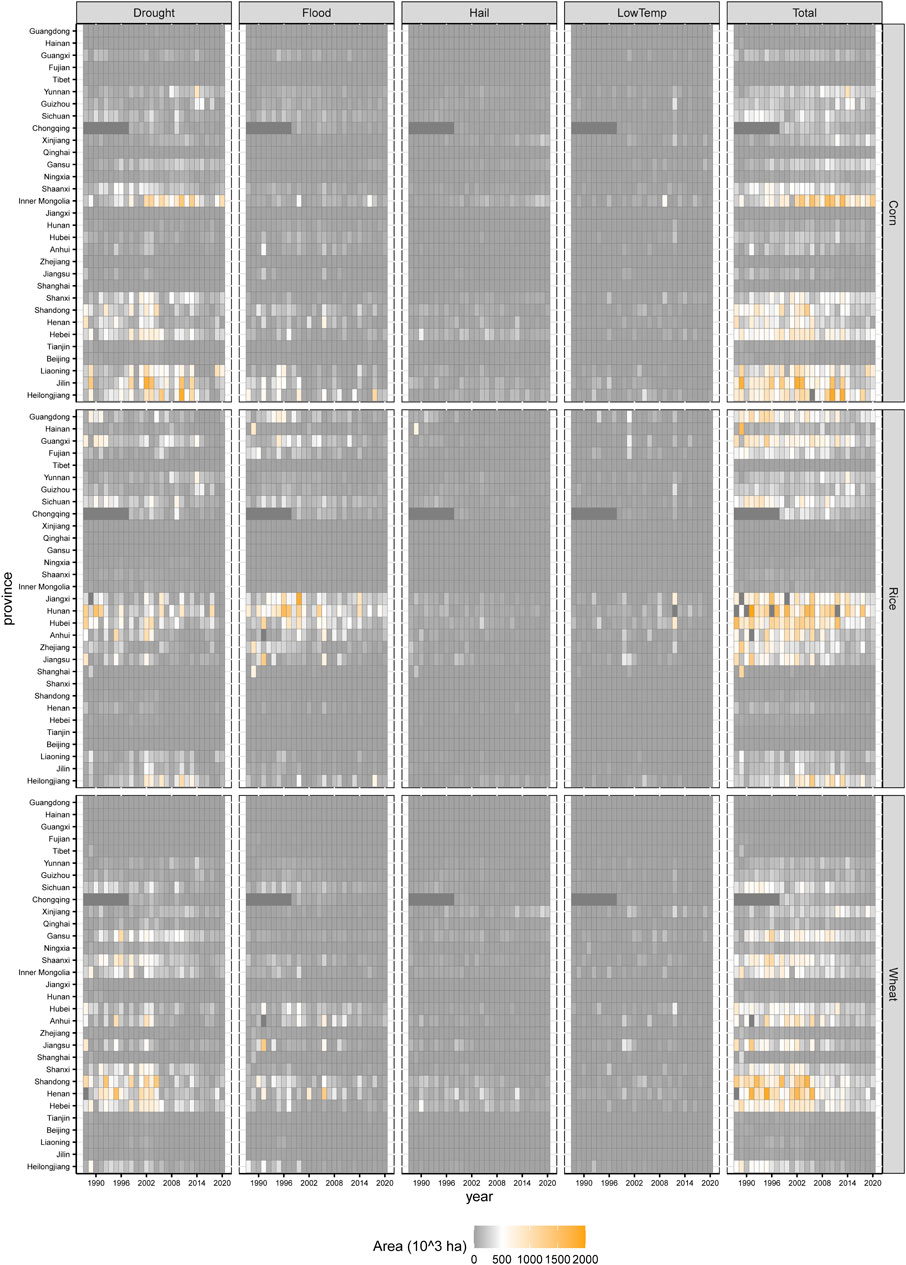
FIGURE 6. Changes in the area affected by different moderate natural disasters for rice, maize, and wheat in each province from 1988 to 2020.
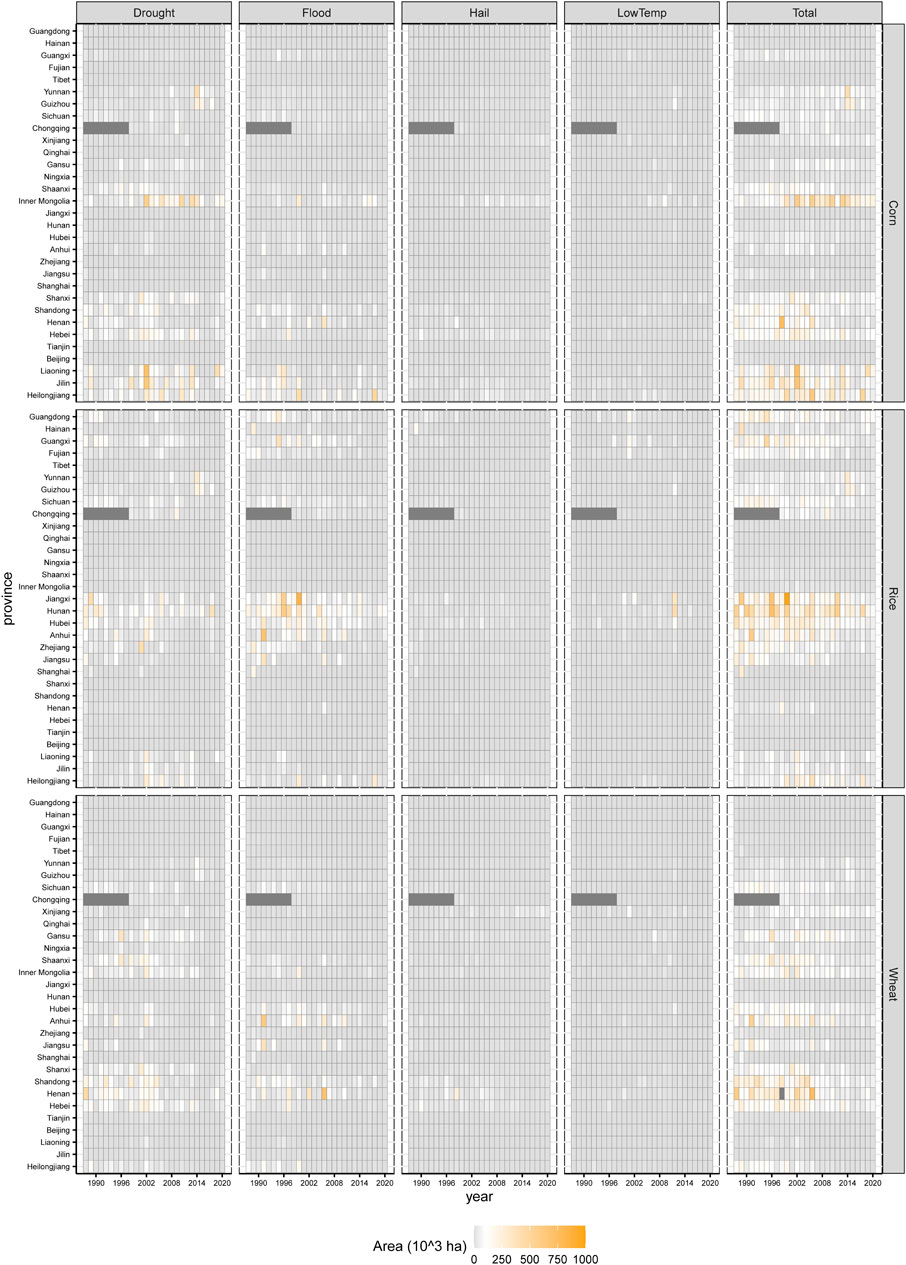
FIGURE 7. Changes in the area affected by different severe natural disasters for rice, maize, and wheat in each province from 1988 to 2020.
Table 1, Table 2, Table 3 illustrate linear changes in grain cultivation areas for each province. For maize, 13 of the 31 provincial units selected for this study showed a significant linear trend in the total area of cereals exposed to all classes of disasters during 1988–2020, with the areas of mild effects in Jilin, Henan, and Shandong decreasing by 41.95, 41.15, and 37.74 thousand ha per year, respectively, and Inner Mongolia’s mildly impacted region increasing by 59.78 thousand ha per year. In addition, for all three disaster classes, all provinces in Northwest China except Shaanxi showed a significant upward trend in the area of rice damage, and drought was often the most significant factor. In most provinces, the area of wheat affected by natural disasters has been decreasing year by year. The exception is Xinjiang Province, where the annual increased in the area affected by mild, moderate, and severe natural disasters were 11.72, 10.42, and 13.6 thousand ha, respectively, showing a significant upward trend from 1988 to 2020. In the case of rice, the area affected by natural disasters decreased in most provinces during the study period, especially in the Yangtze River region, where all provinces showed a significant downward trend except for Shanghai. By contrast, Heilongjiang province showed the opposite trend, with average annual areas affected by mild, moderate, and severe natural disasters of 23.34, 14.16, and 16 thousand ha, respectively, although this trend was not statistically significant.

TABLE 1. Linear changes in the maize cultivation area affected by different natural disasters from 1988 to 2020. * indicates the presence of statistical significance (Ps < 0.05).
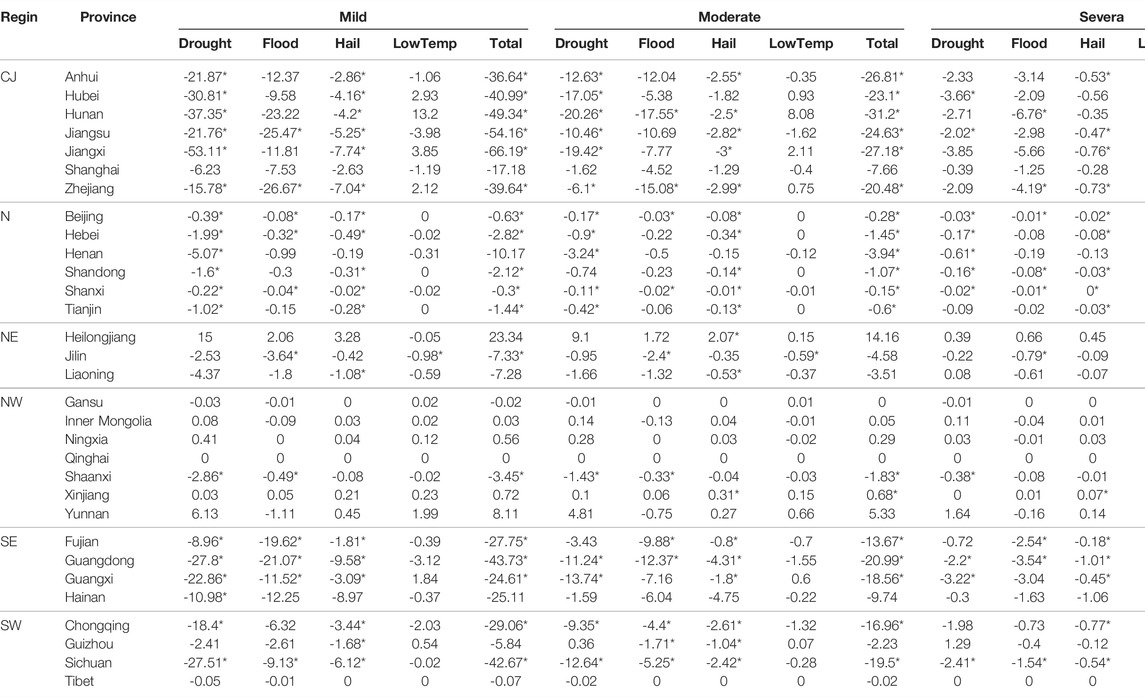
TABLE 2. Linear changes in the rice cultivation area affected by different natural disasters from 1988 to 2020. * indicates the presence of statistical significance (Ps < 0.05).
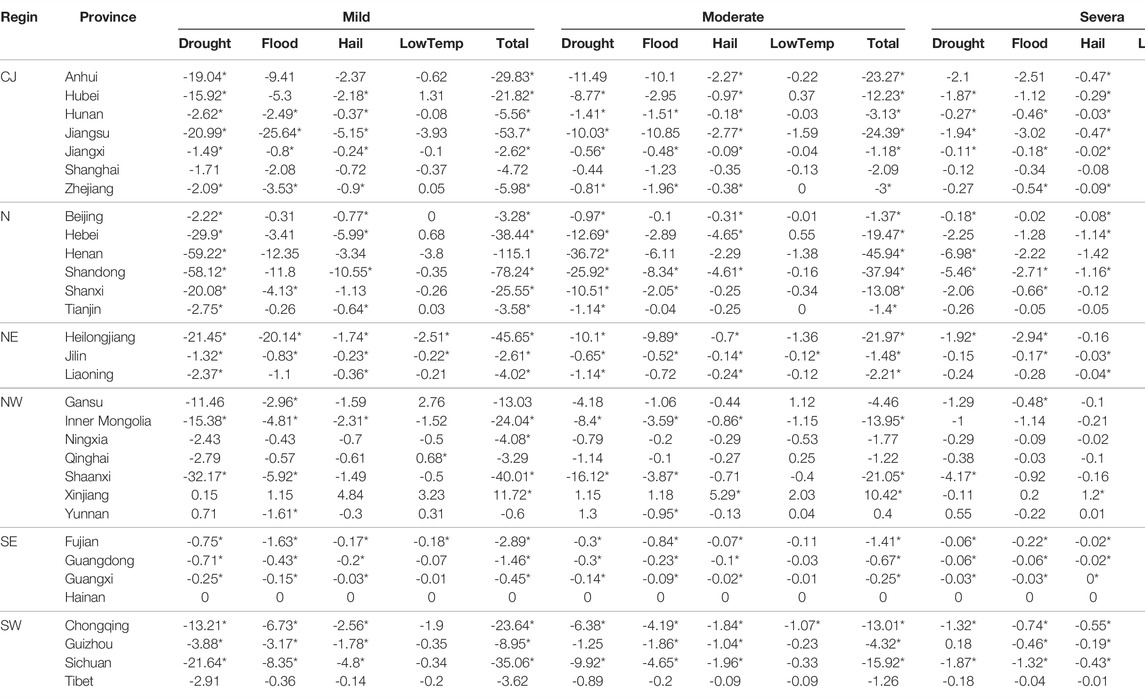
TABLE 3. Linear changes in the wheat cultivation area affected by different natural disasters from 1988 to 2020. * indicates the presence of statistical significance (Ps < 0.05).
Figure 8 depicts protein losses in the cereal harvest due to various natural disasters that occurred between 1988 and 2020. Overall, there was no statistically significant change in the amount of protein lost during the course of the trial. The average annual grain protein losses in maize, rice and wheat were 159.94, 169.01 and 129.35 thousand tons for mild disasters; 230.95, 234.05 and 173.51 thousand tons for moderate disasters; and 92.56, 91.12 and 68.70 thousand tons for severe disasters. In addition, Figure 9 illustrates the protein losses due to different natural disasters in straw harvested from 1988 to 2020; these were much smaller than grain protein losses over the same time period. During the time period selected for the study, the amount of protein loss in maize straw was comparable to that in rice straw and showed no notable changes, however the amount of protein loss in wheat straw decreased after 1997.
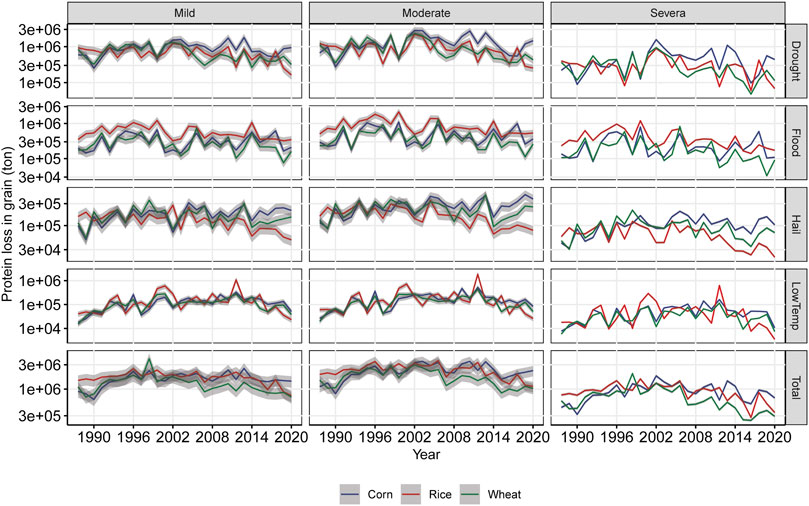
FIGURE 8. Trends in protein loss from the grain harvest in maize, rice, and wheat due to different natural disasters from 1988 to 2020. The shaded regions represent one standard deviation of the protein loss in the grain.
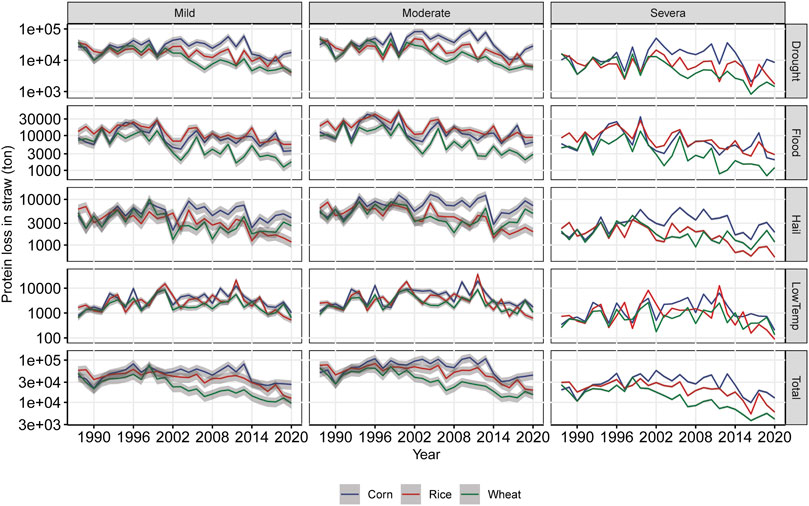
FIGURE 9. Trends in protein loss from the straw harvest in maize, rice, and wheat due to different natural disasters from 1988 to 2020. The shaded regions represent one standard deviation of the protein loss in the straw.
From 1988 to 2020, among the three cereals examined in this study, the protein content of rice was the most severely affected by each level of natural disaster, with a total protein loss of 146.61 million tons due to flood, drought, hailstorms, and low temperatures (Figure 10). Overall, the mean annual total protein losses in maize, rice, and wheat were 1,647.25, 1728.81, and 1,319.14 thousand tons for mild disasters; 2,380.29, 2,394.21, and 1770.60 thousand tons for moderate disasters; and 954.72, 932.38, and 700.93 thousand tons for severe disasters. This shows that moderate natural disasters caused larger amounts of crop protein loss. In addition, Figure 11 depicts the total protein loss of rice, wheat, maize, grain, straw and total during 1988–2020, where both rice and wheat showed a significant decreasing trend (Ps < 0.05), while the total protein loss of maize showed an increasing trend but was not statistically significant (Ps > 0.05). The average annual amount of protein lost in grain and straw due to natural disasters was 13.49 million ton and 0.41 million ton, respectively. The amount of protein lost in both straw and cereal grain showed a decreasing trend, but it was statistically significant only in straw (Ps < 0.05).
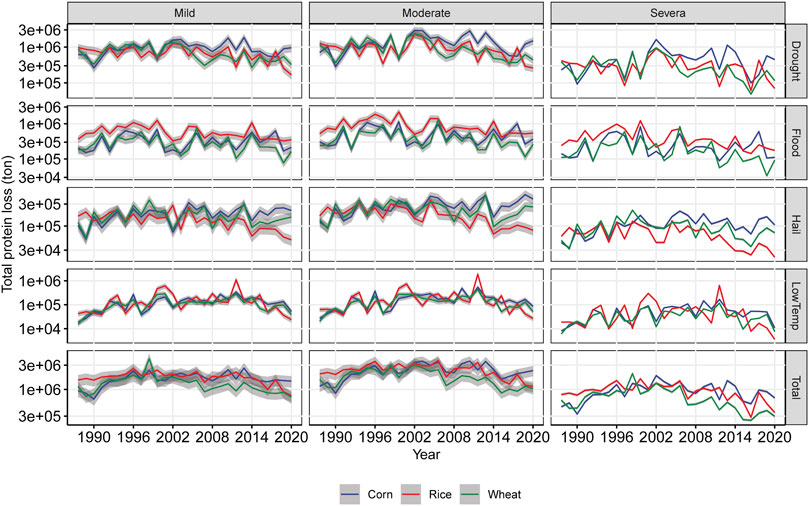
FIGURE 10. Trends in protein loss from agricultural production in maize, rice, and wheat due to different natural disasters from 1988 to 2020. The shaded regions represent one standard deviation of the protein loss in China’s agriculture.

FIGURE 11. Trends in protein losses in maize, rice, wheat, grain, straw and total due to natural disasters in agricultural areas of China, 1988–2020. Lines represent the fitted linear regression trends.
Among the several natural hazards selected for this study, droughts and floods caused most of the crop protein losses during 1988–2020 (Figure 12). For mild disasters, drought loss accounted for more than half of the protein loss from maize, rice, and wheat in 15, 15, and 16 of the 31 provinces, respectively. For moderate natural hazards, drought caused more than half of the protein loss in corn, rice and wheat, respectively, all of which were 14. Floods accounted for more than half of the protein loss from maize, rice, and wheat in 10, 10, and 12 of the 31 provinces, respectively, and drought accounted for more than half of the protein loss from maize, rice, and wheat in 14, 14, and 10 of the 31 provinces, respectively. For severe natural disasters, flooding was an important influencing factor, which caused more than half of the protein losses of corn, rice and wheat 6, 8 and 6, respectively. Meanwhile, this indicator for drought was 11, 12 and 10. In particular, it can be seen in Figure 12 that more than half of the crop protein losses in all provinces of North China are caused by drought.
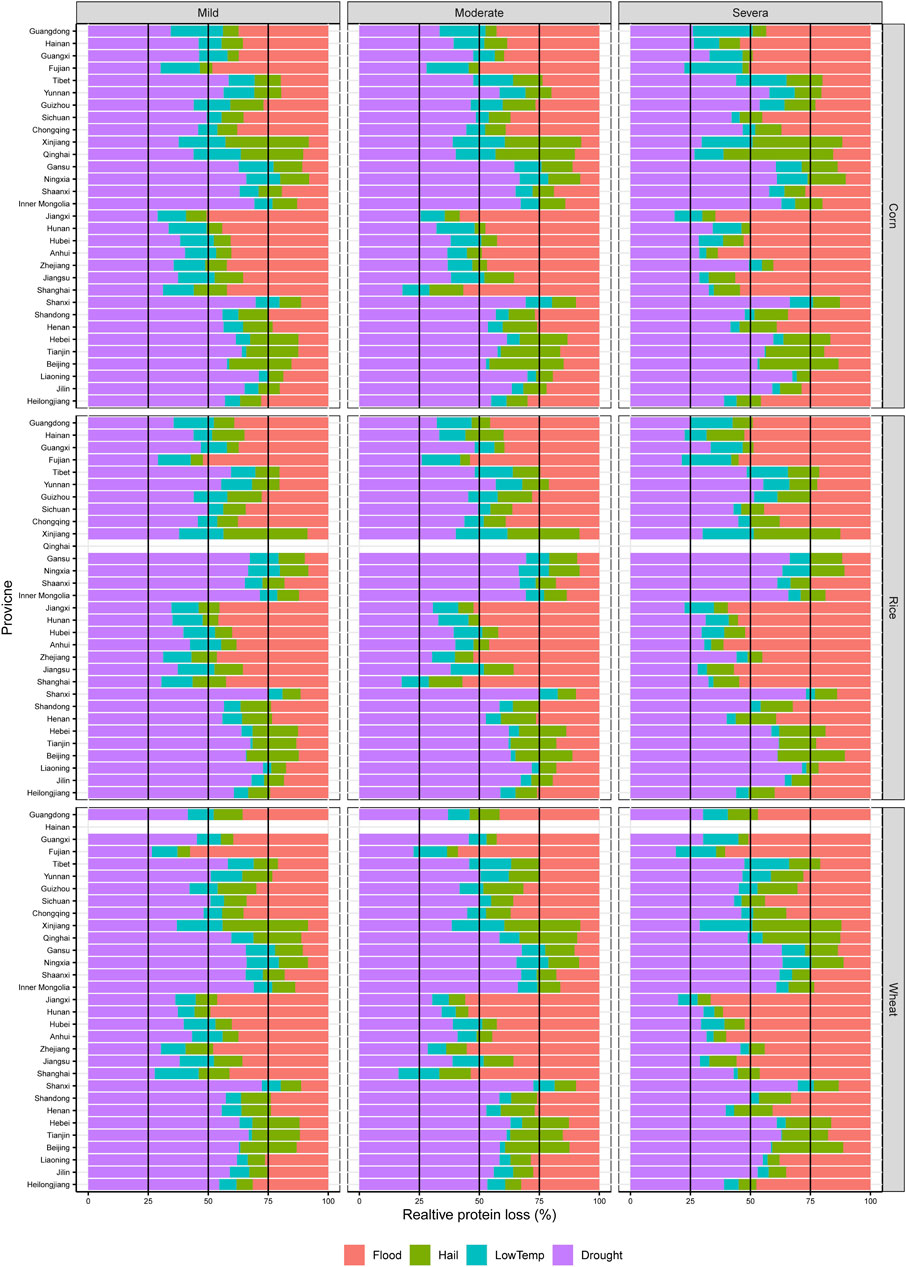
FIGURE 12. Cumulative relative protein loss due to different natural disasters from 1988 to 2020 for each province. The vertical line represents the 25, 50, and 75% contribution to the total loss, respectively. Due to the high protein losses from drought and flood, if the bar for drought or flood overlaps with the vertical lines, more than 50% of the protein loss was caused by that type of disaster.
Using China as an example, we attempted to relate natural disasters to protein losses in agricultural systems. We discovered that: 1) the area of crops affected by natural disasters in China has declined significantly since the twenty-first century; 2) during the period 1988–2020 the area affected by natural disasters differed among provincial units within China; and 3) during the time period selected for this study, the total amounts of protein lost from corn, wheat and rice in grain and straw due to natural disasters in China were 391.26 million and 11.94 million tons, respectively.
Crops are among the most important sources of protein in the human diet. To study the impact of natural disasters on crop protein production (Shewry 2007), we analyzed the frequency and intensity of natural disasters affecting three cereal crops, rice, wheat and maize. Cereal crops accounted for 92.7% of total crop production in 2020 and FAO production data (http://faostat.fao.org) show that these three major species account for about 85% of all cereal crop production and provide more than 200 million tons of cereal protein per year. Because of data limitations, few studies have focused on changes in the area of key agricultural cultivation zones that are affected by natural disasters (Song et al., 2022). To remedy this, we used the cultivation ratio, which reflects the proportionate changes in different crops, to estimate the affected area for the various crops. On this basis, we calculated the maximum proportions of arable land area affected by mild, moderate, and severe natural disasters as 77.05, 42.33, and 11.89%, respectively, and all of these maxima occurred at the beginning of the 21st century. From Figure 3, we can see that the area affected by natural disasters in China has decreased year by year in recent years. Another study has also shown that the area affected by crop disasters in China decrease between 1978 and 2012 as a result of efforts of local and central governments and the implementation of various effective measures (Liu and Li 2017). This result also implies that China’s long-standing measures, such as strengthening agricultural infrastructure and increasing subsidies for agricultural insurance, have been effective and can be replicated in other developing countries that are plagued by natural disasters.
Previous studies have analyzed changes in the area affected by natural hazards in China over various time scales, but such studies have tended to be on a national scale, which may obscure the various impacts of natural disasters on a smaller scale. This study analyzes the areas affected by different classes and types of natural disaster within each provincial unit of China from 1988 to 2020, and the results show that there are differences among provinces and regions affected by different natural disasters. Nonetheless, the area affected in most provinces has been decreasing year by year in recent years, consistent with the findings of a study of meteorological hazards in China from 1979 to 2008. Only areas of corn production in Inner Mongolia and wheat production in Xinjiang have shown significant increases in natural disasters. (Sang and Hao 2019). China’s vast territory, complex geography, and multiple climate types are important reasons for the differences in disaster status among provinces over the past 3 decades (Shahzad et al., 2021; Ma et al., 2022). This study shows that drought and flood are the main types contributors to of crop damage in China, and the northeastern region is most severely affected.
The significant hazards of natural disasters for crop yields have been demonstrated, and an increasing number of researchers have analyzed the impact of natural disasters on crop yields in China at spatial and temporal scales in recent years. However these studies have tended to focus on large scales, such as national or geographic regions. This study reports a more comprehensive analysis of protein losses in grain and straw of three major cereal crops caused by different levels and types of natural disasters at national, regional and provincial scales. Most of the protein in cereal crops is concentrated in the grain and straw, and the amount of protein lost in grain due to natural disasters in China during 1988–2020 was 391.27 million tons, about 30 times that in straw. This result clearly shows the important role of grains in protein supply. However, the contribution of straw to protein supply as an excellent raw material for feed and fertilizer cannot be ignored. Our results show that the total protein loss in wheat and rice due to various natural disasters decreased significantly over the time frame examined in this paper, indicating that disaster prevention and mitigation measures implemented in China in past years have had some positive effects. FAO production data from 2001 to 2005 (http://faostat.fao.org) shows that the average annual production of all cereals exceeds 2,100 million tons, of which the three major species (maize, wheat, and rice) account for about 85%. Even with a conservative estimate of 10% protein content, this translates into an annual harvest of more than 200 million tons of cereal protein. Information from the National Bureau of Statistics of China shows that the total production of these three crops has reached 658 million tons in 2018, suggesting that at least 65.8 million tons of protein was harvested from corn, wheat and rice in China in 2018. Increasing the protein content of cereals has long been an important means of addressing the “protein gap” and increasing per capita protein intake in developing countries, and with global warming and a rising human demand for crops, the impact of natural disasters on global protein supply must be given more attention. Moreover, in more than half of Chinese provinces, protein loss due to drought accounts for more than half of the total protein loss, and previous studies have demonstrated that drought has a great impact on crop yield. The use of various types of drought resistance to improve the protein yield of cereal crops may therefore be an important direction for future development.
This study had a number of drawbacks. The first is the model parameters that were used to calculate protein loss due to natural calamities. Due to the paucity of observational data, regional parameters (grain to straw ratio, straw return, and burning rate) were used in this study rather than province-level data, and the protein concentrations in straw were examined using average data from throughout the entire study area. As a result, critical parameters at the province level will be required for a more precise analysis in the future. Because there were no precise data on the affected areas of maize, rice, and wheat, the second constraint is the exact affected area for each individual crop. We calculated the affected area for each crop by assuming a ratio of individual cultivation to overall cultivation area. As a result, a customized dataset for each crop’s affected area will need to be compiled in the future.
Our work shows that the impact of natural disasters on Chinese agriculture, led by droughts, floods, hailstorms and low temperatures, has significantly weakened since the 21st century, although there were different patterns of variation at the provincial level. Although existing disaster prevention and mitigation measures in China have been effective and can be extended to other developing countries, the impact of natural disasters, especially drought, on the protein harvest of cereal crops requires greater attention in the context of global warming and green and sustainable development. We put forward the following suggestions for coping with agricultural natural disasters: 1) Establish well-developed early warning and monitoring systems for natural disasters, especially high-technology systems; 2) Strengthen the construction of irrigation infrastructure, such as water storage and irrigation facilities to avoid drought; 3) Develop and cultivate new crop species, such as drought-tolerant crops; 4) Establish a sound insurance system to reduce losses of agricultural producers.
The original contributions presented in the study are included in the article/Supplementary Material, further inquiries can be directed to the corresponding author.
DH Conceptualization, Methodology, Software. YC: Data curation, Writing- Original draft preparation. PC: Visualization, Investigation, Writing- Reviewing and Editing. QZ: Supervision.
The authors declare that the research was conducted in the absence of any commercial or financial relationships that could be construed as a potential conflict of interest.
The reviewer QQ declared a shared affiliation with the authors DH, YC, QZ to the handling editor at the time of review.
All claims expressed in this article are solely those of the authors and do not necessarily represent those of their affiliated organizations or those of the publisher, the editors, and the reviewers. Any product that may be evaluated in this article, or claim that may be made by its manufacturer, is not guaranteed or endorsed by the publisher.
The Supplementary Material for this article can be found online at: https://www.frontiersin.org/articles/10.3389/fenvs.2022.884754/full#supplementary-material
Du, X., Jin, X., Yang, X., Yang, X., Xiang, X., and Zhou, Y. (2015). Spatial-temporal Pattern Changes of Main Agriculture Natural Disasters in China during 1990-2011. J. Geogr. Sci. 25, 387–398. doi:10.1007/s11442-015-1175-x
Fang, L., Yang, C., and Peng, L. (2011). An Empirical Study on the Impacts of Natural Disasters on China's Grain Output——Taking Paddy Rice as an Example. Chin. Rural Economy 5, 33–44.
Guan, Y., Zheng, F., Zhang, P., and Qin, C. (2015). Spatial and temporal changes of meteorological disasters in China during 1950-2013. Nat. Hazards 75, 2607–2623. doi:10.1007/s11069-014-1446-3
Guo, J., Mao, K., Zhao, Y., Lu, Z., and Xiaoping, L. (2019). Impact of Climate on Food Security in Mainland China: A New Perspective Based on Characteristics of Major Agricultural Natural Disasters and Grain Loss. Sustainability 11, 869. doi:10.3390/su11030869
Heird, W. C. (1998). Amino acids in pediatric and neonatal nutrition. Curr. Opin. Clin. Nutr. Metab. Care 1, 73–78. doi:10.1097/00075197-199801000-00012
Lei, Y., and Wang, J. a. (2014). A preliminary discussion on the opportunities and challenges of linking climate change adaptation with disaster risk reduction. Nat. Hazards 71, 1587–1597. doi:10.1007/s11069-013-0966-6
Lesk, C., Rowhani, P., and Ramankutty, N. (2016). Influence of extreme weather disasters on global crop production. Nature 529, 84–87. doi:10.1038/nature16467
Liu, L., Sadras, V. O., Xu, J., Hu, C., Yang, X., and Zhang, S. (2021). “Genetic improvement of crop yield, grain protein and nitrogen use efficiency of wheat, rice and maize in China,” in Advances in Agronomy. Editor D. L. Sparks (Academic Press), 203–252. doi:10.1016/bs.agron.2021.02.005
Liu, X., and Li, S. (2017). Temporal and spatial distribution characteristics of crop straw nutrient resources and returning to farmland in China. Trans. Chin. Soc. Agric. Eng. 33, 1–19. doi:10.11975/j.issn.1002-6819.2017.21.001
Luo, X. (2006). Study of Nuclear Analysis Method for the Measurement of Protein Content and Depth Distribution in Grain Seeds. Sichuan: Sichuan University.
Ma, Q., Mentel, G., Zhao, X., Salahodjaev, R., and Kuldasheva, Z. (2022). Natural resources tax volatility and economic performance: Evaluating the role of digital economy. Resour. Pol. 75, 102510. doi:10.1016/j.resourpol.2021.102510
Null, R., Team, R., Null, R., Writing, T. C., Null, R., Team, R., et al. (2011). R: A language and environment for statistical computing. Computing 1, 12–21.
Organization, W. H. (2018). The State of Food Security and Nutrition in the World 2018: Building Climate Resilience for Food Security and Nutrition. Rome: Food & Agriculture Org.
Sang, J., and Hao, L. (2019). Spatio-temporal patterns of typical agro-meteorological disasters in China in the past 30 years. Chin. J. Eco-Agriculture 26, 1302–1314. doi:10.13930/j.cnki.cjea.170697
Shahzad, U., Ferraz, D., Nguyen, H.-H., and Cui, L. (2022). Investigating the spill overs and connectedness between financial globalization, high-tech industries and environmental footprints: Fresh evidence in context of China. Technol. Forecast. Soc. Change 174, 121205. doi:10.1016/j.techfore.2021.121205
Shahzad, U., Schneider, N., and Ben Jebli, M. (2021). How coal and geothermal energies interact with industrial development and carbon emissions? An autoregressive distributed lags approach to the Philippines. Resour. Pol. 74, 102342. doi:10.1016/j.resourpol.2021.102342
Shewry, P. R. (2007). Improving the protein content and composition of cereal grain. J. Cereal Sci. 46, 239–250. doi:10.1016/j.jcs.2007.06.006
Shi, W., and Tao, F. (2014). Spatio-temporal distributions of climate disasters and the response of wheat yields in China from 1983 to 2008. Nat. Hazards 74, 569–583. doi:10.1007/s11069-014-1197-1
Shutian, L., Jiyun, J., and Jiehua, Z. (2011). Characteristics of nutrient input/output and nutrient balance in different regions of China. China Agric. Sci. 678, 720–725. doi:10.4028/www.scientific.net/amm.678.720
Simelton, E. (2011). Food self-sufficiency and natural hazards in China. Food Sec. 3, 35–52. doi:10.1007/s12571-011-0114-7
Song, M., Tao, W., Shang, Y., and Zhao, X. (2022). Spatiotemporal characteristics and influencing factors of China's urban water resource utilization efficiency from the perspective of sustainable development. J. Clean. Prod. 338, 130649. doi:10.1016/j.jclepro.2022.130649
Song, M., Zhao, X., and Shang, Y. (2020). The impact of low-carbon city construction on ecological efficiency: Empirical evidence from quasi-natural experiments. Resour. Conservation Recycling 157, 104777. doi:10.1016/j.resconrec.2020.104777
Wang, Q., Zhang, Q.-p., Liu, Y.-y., Tong, L.-j., Zhang, Y.-z., Li, X.-y., et al. (2020). Characterizing the spatial distribution of typical natural disaster vulnerability in China from 2010 to 2017. Nat. Hazards 100, 3–15. doi:10.1007/s11069-019-03656-7
Wang, Z. C., and Kang, Y. L. (2006). Status of Development on Cereal Protein. Chin. Food Addi. 5, 110–113.
Westerterp-Plantenga, M. S. (2003). The significance of protein in food intake and body weight regulation. Curr. Opin. Clin. Nutr. Metab. Care 6, 635–638. doi:10.1097/00075197-200311000-00005
Xia, W., Apergis, N., Bashir, M. F., Ghosh, S., Doğan, B., and Shahzad, U. (2022). Investigating the role of globalization, and energy consumption for environmental externalities: Empirical evidence from developed and developing economies. Renew. Energ. 183, 219–228. doi:10.1016/j.renene.2021.10.084
Zhao, X., Ma, X., Shang, Y., Yang, Z., and Shahzad, U. (2022b). Green economic growth and its inherent driving factors in Chinese cities: Based on the Metafrontier-global-SBM super-efficiency DEA model. Gondwana Res. 106, 315–328. doi:10.1016/j.gr.2022.01.013
Zheng, D., Zhang, H., Yuan, Y., Deng, Z., Wang, K., Lin, G., et al. (2020). Natural disasters and their impacts on the silica losses from agriculture in China from 1988 to 2016. Phys. Chem. Earth, Parts A/B/CParts A/B/C 115, 102840. doi:10.1016/j.pce.2020.102840
Keywords: natural disasters, agricultural, protein losses, sustainable production, China
Citation: Huang D, Chen Y, Chen P and Zheng Q (2022) The Protein Losses of Three Major Cereal Crops by Natural Disasters in China From 1988 to 2020. Front. Environ. Sci. 10:884754. doi: 10.3389/fenvs.2022.884754
Received: 27 February 2022; Accepted: 28 March 2022;
Published: 25 April 2022.
Edited by:
Gagan Deep Sharma, Guru Gobind Singh Indraprastha University, IndiaReviewed by:
Qingyan Qiu, Fujian Agriculture and Forestry University, ChinaCopyright © 2022 Huang, Chen, Chen and Zheng. This is an open-access article distributed under the terms of the Creative Commons Attribution License (CC BY). The use, distribution or reproduction in other forums is permitted, provided the original author(s) and the copyright owner(s) are credited and that the original publication in this journal is cited, in accordance with accepted academic practice. No use, distribution or reproduction is permitted which does not comply with these terms.
*Correspondence: Qingchang Zheng, dGd6MjAyMUAxMjYuY29t
Disclaimer: All claims expressed in this article are solely those of the authors and do not necessarily represent those of their affiliated organizations, or those of the publisher, the editors and the reviewers. Any product that may be evaluated in this article or claim that may be made by its manufacturer is not guaranteed or endorsed by the publisher.
Research integrity at Frontiers

Learn more about the work of our research integrity team to safeguard the quality of each article we publish.